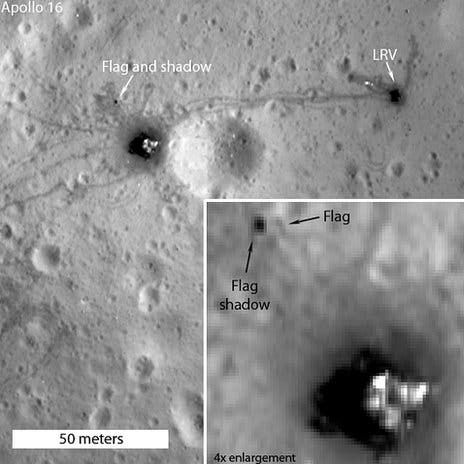Just last week, man’s first step on the moon turned 43 years. Uncoincidently, maybe, NASA announced recently that its Lunar Reconaissance Orbiter (LRO) has captured conclusive images to show that almost all American flags hung by astronauts on the moon are still in their rightful place, undisturbed. Maybe only withered.

The Apollo 16 mission flag, still in place to this day, as seen in this photo captured by the LRO. (c) NASA
The images aren’t very clear, and present flags are really small in depiction. A high-res picture of the flags well in place would’ve shattered any doubt that has risen in past years concerning the survival of Apollo landing banners. Alas, these latest pics from LRO, poor quality albeit, all but suffice, since it clearly shows a shadow. By superimposing the flag sites with photos taken by the spacecraft hovering around the moon at different times of the day, one can clearly see shadows circling the points where the flags are thought to be. Yup, they’re planted alright, all but the very first flag, planted by Buzz Aldrin and Neil Armstrong during mankind’s maiden voyage to the moon. Apparently, the flag was knocked over by engine exhaust as Apollo 11 lifted off.
However, the rest of flags planted during the other six manned Apollo missions are well in place. Rather incredible considering the banners were made out of nylon and were subjected to decades of harsh conditions.
“Intuitively, experts mostly think it highly unlikely the Apollo flags could have endured the 42 years of exposure to vacuum, about 500 temperature swings from 242 F during the day to -280 F during the night, micrometeorites, radiation and ultraviolet light, some thinking the flags have all but disintegrated under such an assault of the environment,” James Fincannon, of the NASA Glenn Research Center in Cleveland.
LRO launched in June 2009, and first captured close-up images of the Apollo landing sites in July of that year. The $504 million car-size spacecraft is currently on an extended mission through at least September 2012.
Prof Mark Robinson, the chief scientist for the spacecraft’s camera instrument, LROC, said in a blog entry: “From the LROC images it is now certain that the American flags are still standing and casting shadows at all of the sites, except Apollo 11.”
The Arizona State University scientist added: “The most convincing way to see that the flags are still there, is to view a time series of LROC images taken at different times of day, and watch the shadow circle the flag.”
“Personally I was a bit surprised that the flags survived the harsh ultraviolet light and temperatures of the lunar surface, but they did. What they look like is another question (badly faded?)”









